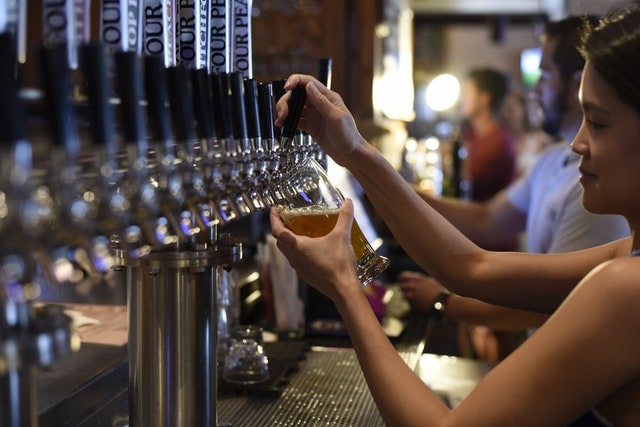
Although we can sometimes get snarky about beer rankings that are essentially built to drive traffic to financial and real estate sites, we usually check them out anyway and maybe you do as well..
The latest comes from Real Estate Witch and its ranking is based on brewery data derived from BreweryDB and publically available census data…
Their weighted ranking evaluated…
- The number of breweries within each metro area
- The density of breweries per 100 square miles
- The number of beers per brewery
- The number of beer styles per brewery
What made this ranking both questionable, and at the same time stupid fun, was that it factored in the average number of beers and beer styles per brewery into the overall listing.
Key Insights
 Collectively, the 50 metro areas Red Witch examined offer a total of approximately 70,067 unique beers.
Collectively, the 50 metro areas Red Witch examined offer a total of approximately 70,067 unique beers.- The average American brewery offers 19 different brews — but the metro areas in its top 15 all offered more variety, with an average of 28 types of beer per brewery.
- Among the 50 metro areas it ranked, six are located in California. These California-based metros collectively boast 423 breweries, or 13% of the total number of breweries on their list.
- Portland, Ore., has the most breweries in a single city, with an impressive 183, or more than seven breweries per 100,000 residents.
- Nine metro areas on its list have more than 100 breweries: Portland; Chicago; Los Angeles; Denver; San Francisco; Philadelphia; New York; Minneapolis-St. Paul, Minn.; and Indianapolis.
- At the bottom of its list, Salt Lake City and Riverside, Calif., stand out for having the fewest breweries — with zero each.
And now (drum roll please)…
50 Best Beer Cities according to Real Estate Witch
|
Metro Area |
Breweries |
Avg. Beers per Brewery |
Avg. Beer Styles per Brewery |
|
|---|---|---|---|---|
| 1 | San Francisco, CA | 144 | 19 | 11 |
| 2 | Indianapolis, IN | 102 | 39 | 20 |
| 3 | Chicago, IL | 180 | 32 | 15 |
| 4 | Philadelphia, PA | 139 | 26 | 15 |
| 5 | Los Angeles, CA | 158 | 20 | 12 |
| 6 | Portland, OR | 183 | 19 | 11 |
| 7 | Denver, CO | 155 | 24 | 14 |
| 8 | Tampa, FL | 83 | 29 | 13 |
| 9 | Cleveland, OH | 49 | 33 | 17 |
| 10 | San Diego, CA | 69 | 36 | 14 |
| 11 | Cincinnati, OH | 67 | 33 | 17 |
| 12 | Minneapolis-St. Paul, MN | 121 | 18 | 12 |
| 13 | Baltimore, MD | 55 | 30 | 14 |
| 14 | Detroit, MI | 58 | 30 | 15 |
| 15 | Columbus, OH | 60 | 30 | 15 |
| 16 | Washington, D.C. | 88 | 23 | 14 |
| 17 | Charlotte, NC | 76 | 19 | 11 |
| 18 | Milwaukee, WI | 58 | 16 | 10 |
| 19 | New York, NY | 135 | 18 | 8 |
| 20 | Boston, MA | 94 | 18 | 10 |
| 21 | Raleigh, NC | 53 | 15 | 11 |
| 22 | Pittsburgh, PA | 72 | 23 | 11 |
| 23 | Seattle, WA | 97 | 14 | 9 |
| 24 | Dallas-Fort Worth, TX | 84 | 16 | 12 |
| 25 | Austin, TX | 71 | 15 | 10 |
| 26 | St. Louis, MO | 63 | 21 | 12 |
| 27 | Hartford, CT | 50 | 9 | 7 |
| 28 | Atlanta, GA | 58 | 20 | 12 |
| 29 | Providence, RI | 41 | 12 | 8 |
| 30 | Richmond, VA | 37 | 26 | 11 |
| 31 | Houston, TX | 52 | 17 | 11 |
| 32 | Kansas City, MO | 48 | 18 | 11 |
| 33 | San Jose, CA | 9 | 31 | 11 |
| 34 | Buffalo, NY | 39 | 8 | 6 |
| 35 | Phoenix, AZ | 48 | 16 | 12 |
| 36 | Nashville, TN | 40 | 17 | 11 |
| 37 | Louisville, KY | 33 | 16 | 11 |
| 38 | Sacramento, CA | 43 | 17 | 10 |
| 39 | Jacksonville, FL | 34 | 16 | 10 |
| 40 | Oklahoma City, OK | 36 | 14 | 9 |
| 41 | San Antonio, TX | 22 | 17 | 11 |
| 42 | Virginia Beach, VA | 33 | 11 | 7 |
| 43 | Miami, FL | 34 | 14 | 8 |
| 44 | Orlando, FL | 30 | 11 | 9 |
| 45 | Las Vegas, NV | 29 | 12 | 10 |
| 46 | Birmingham, AL | 18 | 15 | 8 |
| 47 | Memphis, TN | 9 | 13 | 9 |
| 48 | New Orleans, LA | 20 | 7 | 5 |
| 49 | Riverside, CA | – | – | – |
| 50 | Salt Lake City, UT | – | – | – |
Methodology
All data related to the breweries were sourced from breweryDB.com.
Using breweryDB’s map search, Real Estate Witch curated a list of breweries within 25 miles of the top 50 most populous metropolitan areas in the U.S.
To gather data about varieties and styles of beer, it used each brewery’s breweryDB.com profile to gather:
- The number of beers
- The number of styles of beers (e.g., American Pale Ale)
Then the real estate site averaged the numbers of beers and beer styles across each metro area. Unfortunately those breweries that did not have any beers listed on BreweryDB were not used in the calculations, so there’s that.
 American Craft Beer The Best Craft Beer, Breweries, Bars, Brewpubs, Beer Stores, And Restaurants Serving Serious Beer.
American Craft Beer The Best Craft Beer, Breweries, Bars, Brewpubs, Beer Stores, And Restaurants Serving Serious Beer.
